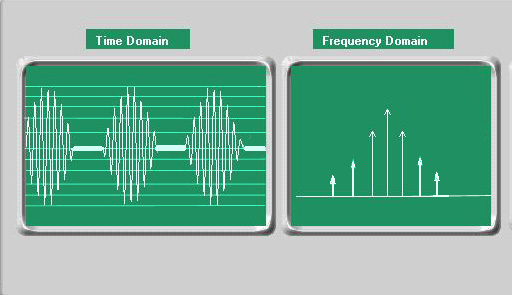
Over Modulation and it's effects

Above is a graphic showing an overmodulated signal on both an oscilloscope and a spectrum analyzer.
This is were we begin to get into UNsymmetrical modulation.
When the peak envelope voltage is more than twice the unmodulated value the modulation percentage is more than 100%. The peak envelope power will be more than 4 times the unmodulated value as well. This can only happen on the positive modulation swings. The negative modulation can never exceed 100% because the carrier voltage can never be less than zero. So, when we overmodulate we enter into a situation where the modulation is unsymmetrical and the signal becomes distorted.
You can see on the scope display where the negative modulation swings are clipped (the carrier is reduced to zero) at the center (zero voltage) line for a certain length of time each cycle. Forcing the carrier to be completely cut-off for any length of time causes distortion of the signal. That distortion shows up on the spectrum analyzer as new sidebands that are outside the alloted frequency range for the channel you're talking on. For example, let's say you're talking on Channel 20. The carrier frequency for Channel 20 is 27.205 Mhz. The sidebands are equal to the carrier frequency plus and minus the highest and lowest expected audio frequencies. With voice communications the highest expected audio frequency is 3000 Hz. That means all the "stuff" (carrier and voice information) should be between 27.202 MHz and 27.208 MHz. When overmodulation takes place extra "stuff" is created well beyond those frequency limits. That's what "bleedover" is. When you hear bleedover you're hearing someone else's extra "stuff." Distortion of the positive modulation swings can also take place during overmodulation. The results are the same in either case.
When transmission takes place most of the energy is contained in the main or "fundamental" frequency range. For example, as mentioned earlier, the fundamental frequency range for CB Channel 20 is 27.202 to 27.208 MHz. Unfortunately, there are also much smaller amounts of energy at frequencies other than the fundamental frequency range. Most of the other energy is contained in what are called "harmonics." Harmonics are integer (whole number) multiples of the fundamental frequencies. When overmodulation takes place the amount of energy contained in the harmonics increases dramatically. The radiated harmonic energy can cause increased levels of interference to other electronic devices such as phones, stereos, televisions, and radios operating in other frequency ranges completely removed from CB.
And finally, when overmodulation takes place, the audio signal used to modulate the carrier is distorted. The higher the level of overmodulation, the worse the distortion becomes. In other words, the test tone or the voice information that is being transmitted is changed in a detrimental way when overmodulation takes place.
That's the bad news about overmodulation. Now for the good news:
Overmodulation increases the energy contained in the sidebands of the fundamental signal. If you'll recall, the sidebands are where the infomation you're trying to convey is contained. Anything that increases the energy contained in the sidebands will make your signal sound louder. The increase in sideband energy will increase the signal's range as well. Also, with voice communications, alot of distortion of the voice information can be tolerated. In other words, you can overmodulate quite a bit before the voice quality gets so bad that people on the receiving end begin to have trouble understanding you.
So, there is something to be gained by overmodulating, but there's also a price that has to be paid for doing so. In the end, the choice is yours.
Next, we'll be discussing modulation percentage measurements. We'll also be discussing power meters and how their measurements can differ from the measurements made with a scope.